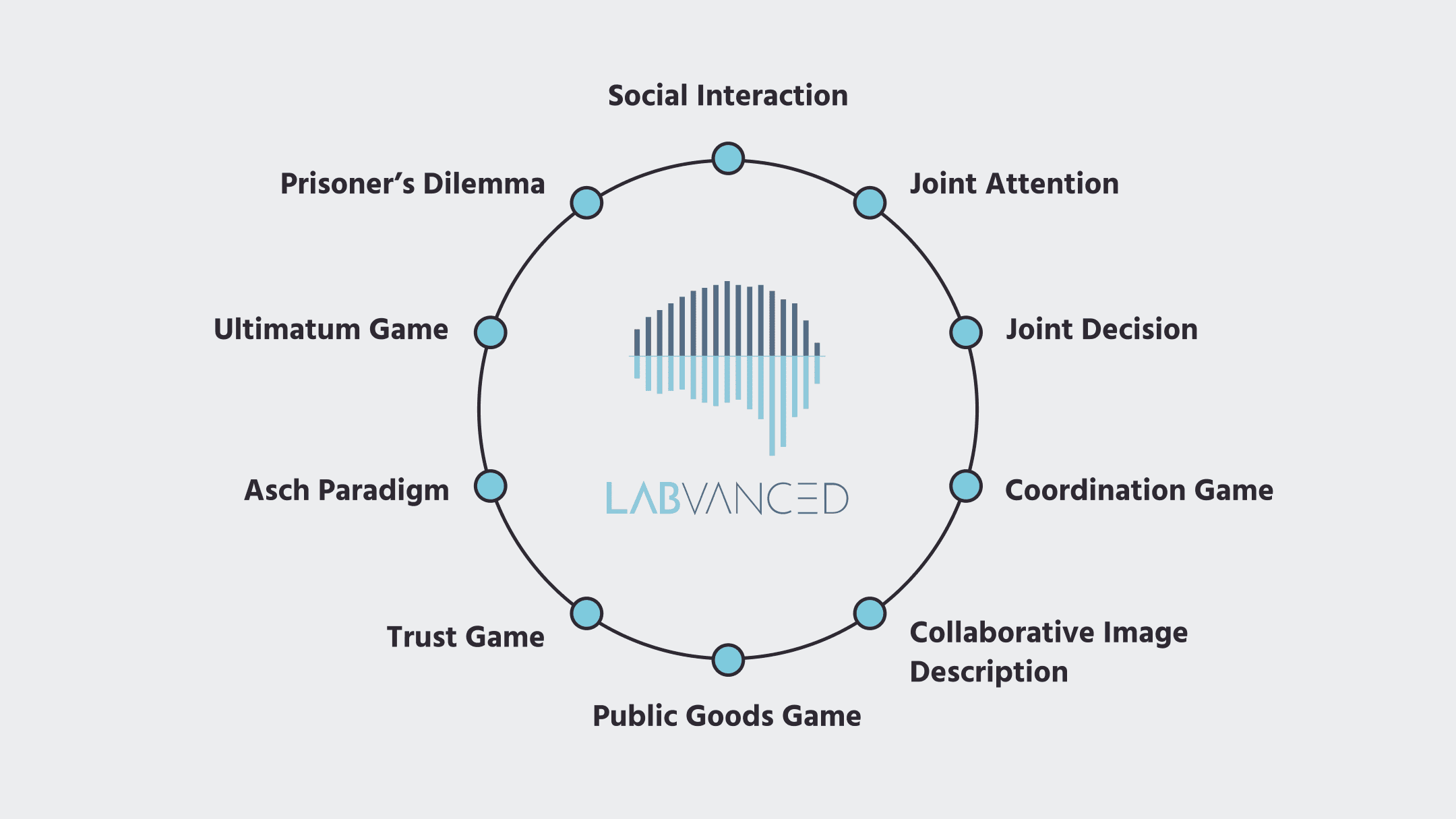
Multi-User Studies
Background & Context
Multi-user studies are a unique type of experimental setup which involves 2 or more people taking parts in one study. The predominant domain for multi-user studies includes behavioral economics and game theories.

Because multi-user studies involve more than one person, they are at the heart of social psychology. Thus, researchers in this field use this type of experimental setup to study how cognitive processes like decision-making and attention are affected in the context of multiple users.
Different Strategies for Conducting Multi-Participant Psychology Studies
- Strategy 1 - Using Virtual Opponents: The participant is instructed that they are playing with another participant, but in reality it's an algorithm that makes another choice randomly. This strategy is often used because implementing an actual multi-participant design is difficult. The virtual opponent strategy for multi-participant psychology studies is an easy solution but it doesn’t capture true interaction.
- Strategy 2 - With Real Participants: With this strategy, there is real interaction and connection between participants across different devices as data and variables are exchanged in real-time. This is the strategy that Labvanced offers.
Our process: Labvanced pipeline for multi-user studies
How are multi-user experiments made possible in an online study setting? You can base a multi-user study around any concept in Labvanced, it’s just a matter of setting it up appropriately. Labvanced’s framework and technology is designed in such a way that user studies can be created based on your study settings and design.
Helpful video for getting started: Multiuser Studies in Labvanced (2-player description task)
The Importance of Synchronization
In order for a multi-user study to be conducted successfully, the participants must exchange information in real time and their responses must be stored as recorded data so that the researcher can analyze behavior later. Because multi-user experiments require more than two participants, synchronization across screens and also available choices is essential.
For example, during an experiment, each player is presented with a choice to select one of the one of two images which are presented to both users. Should both click on the same image, the one who clicked faster gets that image. This is accomplished by having the server lock the choice for the person that clicked first and distributing the remaining choice to the other player.
In brief, synchronization can be conceptualized as the following:
- An experimental variable is presented.
- The variable is changed by one user.
- This change is distributed to all users who may receive a notification and the new value of the variable.
- In the instance where two users select the same variable, the serves locks the first response value and the local choice is overridden.
- The process repeats across the entire experiment as information and decisions are exchanged back and forth.
About System Architecture and Data Flow
The Distribute Variable
The distribute variable allows for the synchronization and exchange of information between two or more participants. In order to transmit information across users and synchronize the screens and steps, such as when aligning the beginning or each task or frame, a distribute variable is necessary.
The distribute variable allows flexibility in the design study, for example:
- Users can see the same or different things, allowing the researcher to control what users are seeing during the multi-participant experiment.
- Participants can be on different frames or tasks within the same trial.
With the mechanism behind the distribute variable, any kind of experimental logic is possible as different types of information can be transmitted between participants.
The Role ID Variable
The Role ID variable distinguishes between different people because each participant has a different role or presence during the multi-user psychology experiment. While the experiment in the background is identical for all users, the variable role_ID is different for each participant.
For example, If player 1 wants to send something to player 4, then the variable is distributed to the target player based on their assigned ID.
The Lock Procedure
As mentioned previously, the lock procedure ensures that participants don’t select the same response if that’s not allowed. When two variables on two different computers are presented, the server determines who sets the variable, what is remaining, and then synchronizes accordingly.

Cognitive Processes You Can Assess with Labvanced’s Multi-Participant Studies
Some examples of cognitive processes that are assessed using Labvanced’s multi-user capabilities:
- Cooperation: Studying shared rewards by designing studies that assess how individuals reason and optimize in an individual vs. group setting or working together to achieve a common goal.
- Economic group-decision making: Experiments that study social behavior in an economic context using motivations such as reward.
- Competition: Studying how two participants compete with each other or allocate resources.
- Joint Spatial Attention: Collaborating together to improve group performance by having multiple people observing something. For example, an experiment studying air traffic control can assess joint spatial attention, decision-making, and how responsibility is divided to pay attention to various spaces.
Across these different cognitive processes, game theory models are typically used.
LV Library Studies
Try out the studies below to get a sense of how multi-user experiments look like in the platform! Pro tip: If you want to test them out for yourself, simply open a second tab in an in-cognito tab!
- Collaborative Image Description: Two participants collaborate to select the target picture. One participant describes the image using the chat window and the other must select the correct picture out of the four images presented.
- Joint Spatial Attention: Based on a classic paradigm of spatial attention, this experiment requires all participants to agree on the same decision. In the experiment, 4 colored squares are briefly presented, then all but one square disappears. The color may or may not switch. The group’s job is to decide whether the color of the remaining square changed or not.
- Joint Decision (Interacting Minds): In this experiment, cognitive stimuli known as Gabor patches are presented in two groups of six. The goal is for the participants to reach a decision about in which interval the high-contrast Gabor patch was presented.
- Public Goods Game: This 3-user experiment game is an economics game. For each round, every participant secretly decides how much of their private funds to put in the public pot. The rest funds remain to the individual participant. The public funds are then multiplied by 2 and distributed equally among the players as a payoff.
- Trust Game: In this game, you have to make money decisions to allocate between you and another participant. Your decisions impact your earnings, thus to maximize the bonus, the task must be performed well. It is called the trust game because you send money to the other player, the amount is multiplied by 4, and you have to trust the other player to return the amount to you even though they have the choice to return as much or as little as they want!
- Ultimatum Game: In each trial of this task, a certain amount of money is split between the two participants. Each participant suggests to the other how much money they want to give to the other person and how much they want to keep. However, the other person can either accept or decline the offer. If the participant accepts, then each player receives the proposed money. But if the participant declines, nobody receive any money in that round.
- Prisoner’s Dilemma Game: This multi-user study is with a virtual opponent, so you can quickly get started. Each round there is a table of points that you and your co-player will get depending on the option you chose. Each participant must chose without knowing what the other has chosen.
- Asch Paradigm: Both participants are presented with a collection of lines and must decide as a team which line is the same length as the target line.
In this video, we walk through an example of a multiuser study. Some key features of studies that involve more than one participant include chat boxes, shared variables, and feedback frames.
Publications Using Labvanced’s Multi-User Platform
Check out this published experiment that made use of Labvanced’s multi-participant capabilities with game theory models:
The Evolution of Ambiguity in Sender—Receiver Signaling Games Mühlenbernd, R., Wacewicz, S., & Żywiczyński, P. (2022). GamesDoi: https://doi.org/10.3390/g13020020
Helpful Documentation for Multi-User Studies
Key Features of Labvanced Multi-user Studies:
- Remote: Due to the nature of online studies, participants from all over the world can be invited to join in.
- Email invitations: This feature invites other users to participate in a study through a link that is shared via email. When enough users are gathered in the virtual lobby, the experiment can begin.
- Easy to set up: Any existing experiment can be modified to be performed with multiple users. Also, multi-user studies are incredibly complex to code because of the interacting nature of the experiment. Labvanced is designed to support them.
- Recording responses: During the experiment, the variable responses are recorded, including any exchanges through chat.
